1994 CADILLAC SEVILLE stop start
[x] Cancel search: stop startPage 207 of 399
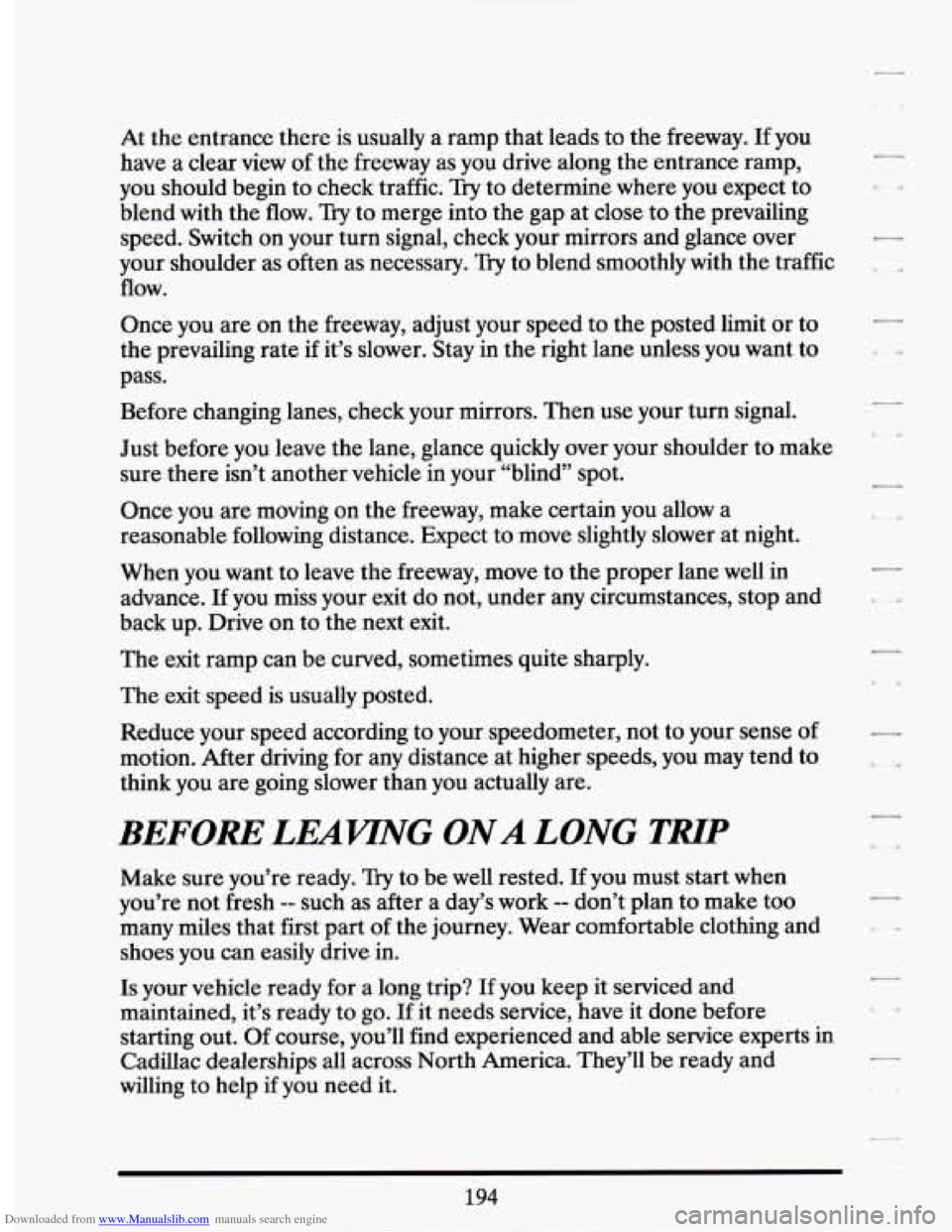
Downloaded from www.Manualslib.com manuals search engine At the entrance there is usually a ramp that leads to the freeway. If you
have
a clear view of the freeway as you drive along the entrance ramp,
you should begin to check traffic.
Try to determine where you expect to
blend with the flow.
Try to merge into the gap at close to the prevailing
speed. Switch on your turn signal, check your mirrors and glance over
your shoulder as often as necessary.
Try to blend smoothly with the traffic
flow.
Once you are on the freeway, adjust your speed to the posted limit or to
the prevailing rate if it’s slower. Stay in the right lane unless you want to
pass.
Before changing lanes, check your mirrors. Then use your turn signal.
Just before you leave the lane, glance quickly over your shoulder to make
sure there isn’t another vehicle in your “blind” spot.
Once you are moving on the freeway, make certain you allow a
reasonable following distance. Expect to move slightly slower at night.
When you want to leave the freeway, move to the proper lane well in
advance.
If you miss your exit do not, under any circumstances, stop and
back up. Drive on to the next exit.
The exit ramp can be curved, sometimes quite sharply.
The exit speed is usually posted.
Reduce your speed according to your speedometer, not
to your sense of
motion. After driving for any distance at higher speeds, you may tend to
think you are going slower than you actually are.
BEFORE LEAVING ONA LONG THP
Make sure you’re ready. Try to be well rested. If you must start when
you’re not fresh
-- such as after a day’s work -- don’t plan to make too
many miles that first part
of the journey. Wear comfortable clothing and
shoes you can easily drive in.
Is your vehicle ready for a long trip? If you keep it serviced and
maintained, it’s ready to go.
If it needs service, have it done before
starting out.
Of course, you’ll find experienced and able service experts in
Cadillac dealerships all across North America. They’ll be ready and
willing to help
if you need it.
Page 221 of 399
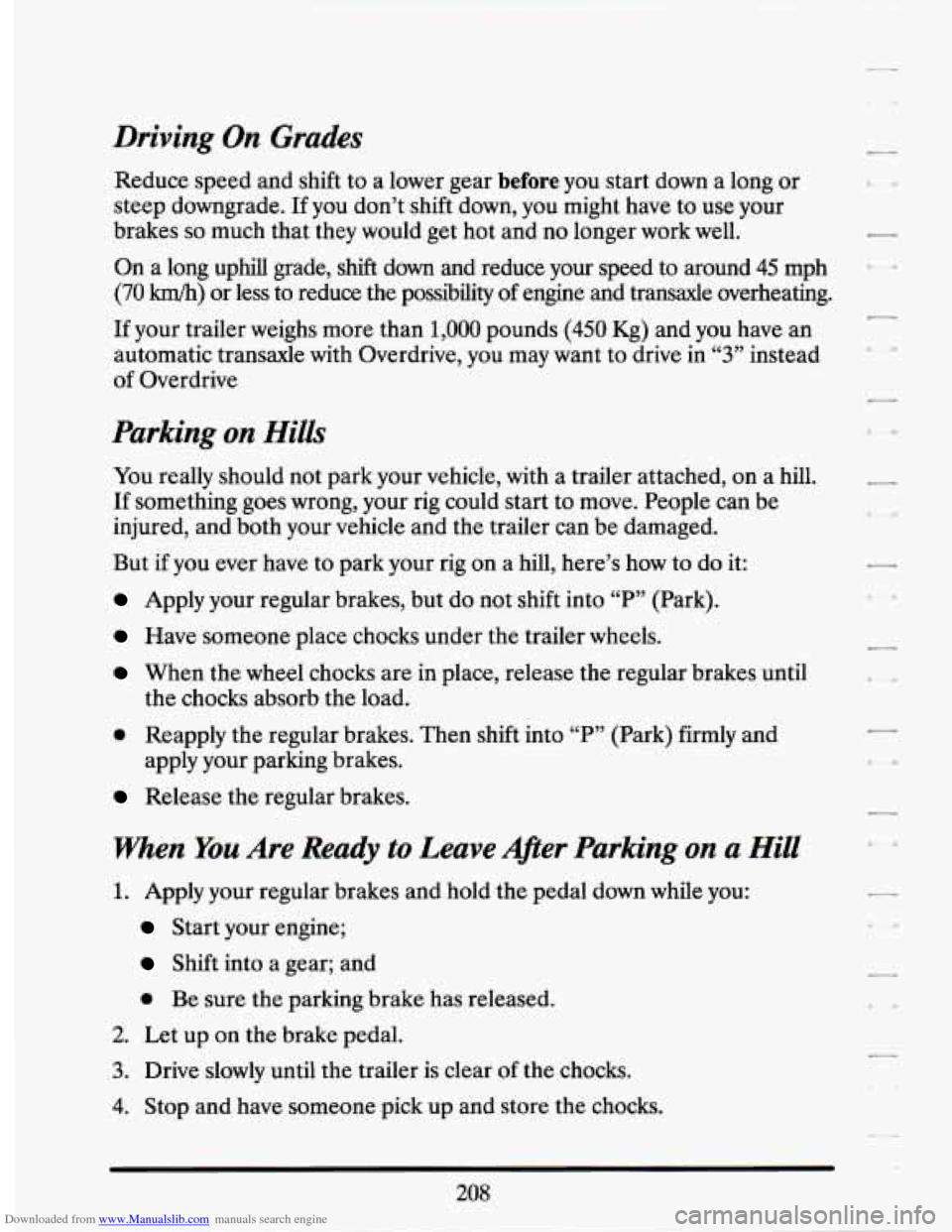
Downloaded from www.Manualslib.com manuals search engine Driving On Grades
Reduce speed and shift to a lower gear before you start down a long or
steep downgrade.
If you don’t shift down, you might have to use your
brakes
so much that they would get hot and no longer work well.
On a long uphill grade, shift down and reduce your speed to around 45 mph
(70 km/h) or less to reduce the possibility of engine and transaxle overheating.
If your trailer weighs more than 1,000 pounds (450 Kg) and you have an
automatic transaxle with Overdrive, you may want to drive in
66 3 ¶? instead
of Overdrive
Parking on Hills
You really should not park your vehicle, with a trailer attached, on a hill.
If something goes wrong, your rig could start to move. People can be
injured, and both your vehicle and the trailer can be damaged.
But
if you ever have to park your rig on a hill, here’s how to do it:
Apply your regular brakes, but do not shift into “P” (Park).
Have someone place chocks under the trailer wheels.
When the wheel chocks are in place, release the regular brakes until
0 Reapply the regular brakes. Then shift into “P” (Park) firmly and
the
chocks absorb the load.
apply your parking brakes.
Release the regular brakes.
when You Are Ready to Leave A@er Parking on a Hill
1. Apply your regular brakes and hold the pedal down while you:
Start your engine;
Shift into a gear; and
0 Be sure the parking brake has released.
2. Let up on the brake pedal.
3. Drive slowly until the trailer is clear of the chocks.
4. Stop and have someone pick up and store the chocks.
208
Page 222 of 399

Downloaded from www.Manualslib.com manuals search engine Engine Cooling When Trailering
Your cooling system may temporarily overheat during severe operating
conditions such as;
Climbing grades steeper than 4% at ambient temperatures above
90 Fahrenheit (32O Celsius) with a loaded vehicle and trailer.
I_ Stopping after high-speed driving.
0 Idling for long periods in stop and go traffic.
If “ENGINE HOT A/C COMPRESSOR
OFF” message appears on the
Driver Information Center, do not be alarmed. This is a normal function
designed to reduce the load
on the engine and cooling system. You can
continue to drive your vehicle.
If “ENGINE COOLANT HOT IDLE ENGINE’’ message appears on
the Driver Information Center, pull off to the side of the road as soon as
it is safe to do
so. When the vehicle is at a complete stop, shift the
the engine or increase engine speed above a normal idle. Within
two or
three minutes the system should cool sufficiently to allow A/C operation
normal driving after
10 minutes if the “ENGINE COOLANT HOT
IDLE ENGINE” message is not displayed.
-
-
transaxle selector to P (Park) and allow the engine to idle. Do not turn off
__ to resume. At that time resume driving at a reduced speed. Return to
__
Maintenance When Trailer Towing
Your vehicle will need service more often when you’re pulling a trailer.
especially important
in trailer operation are automatic transaxle fluid
(don’t overfill), engine oil, belts, cooling system, and brake wear Each of
.- these is covered in this manual, and the Index will help you find them
quickly.
If you’re trailering, it’s a good idea to review these sections
before
you start your trip.
~ See the Maintenance Schedule for more on this. Things that are
- Check periodically to see that all hitch nuts and bolts are tight.
209
Page 244 of 399

Downloaded from www.Manualslib.com manuals search engine 5. Then replace the
pressure cap. Be
sure the arrows on
the pressure cap
line up
like this.
Start the engine and allow it to warm up. If the “ENGINE COOLANT
LOW” message does not appear on the Driver Information Center,
coolant is at the proper fill level. If an “ENGINE COOLANT
LOW”
message does appear, repeat steps 1 to 3 or see your dealer.
IF A TIRE GOES FLAT
It’s unusual for a tire to “blow out” while you’re driving, especially if you
maintain your tires properly. If air goes out of a tire, it’s much more likely
to leak out slowly. But
if you should ever have a “blowout,” here are a
few tips about what to expect and what to do:
If a front tire fails, the flat tire will create a drag that pulls the vehicle
toward that side. Take your foot
off the accelerator pedal and grip the
steering wheel firmly. Steer
to maintain lane position, then gently brake
to a stop well out of the traffic lane.
A rear blowout, particularly on a curve, acts much like a skid and may
require the same correction you’d use in a skid. In any rear blowout,
remove your foot from the accelerator pedal. Get the vehicle under
control by steering the way you want the vehicle to go. It may be
very
bumpy and noisy, but you can still steer. Gently brake to a stop, well off
the road if possible.
If a tire goes flat, the next section shows how to use your jacking
equipment to change a flat tire safely.
Page 260 of 399
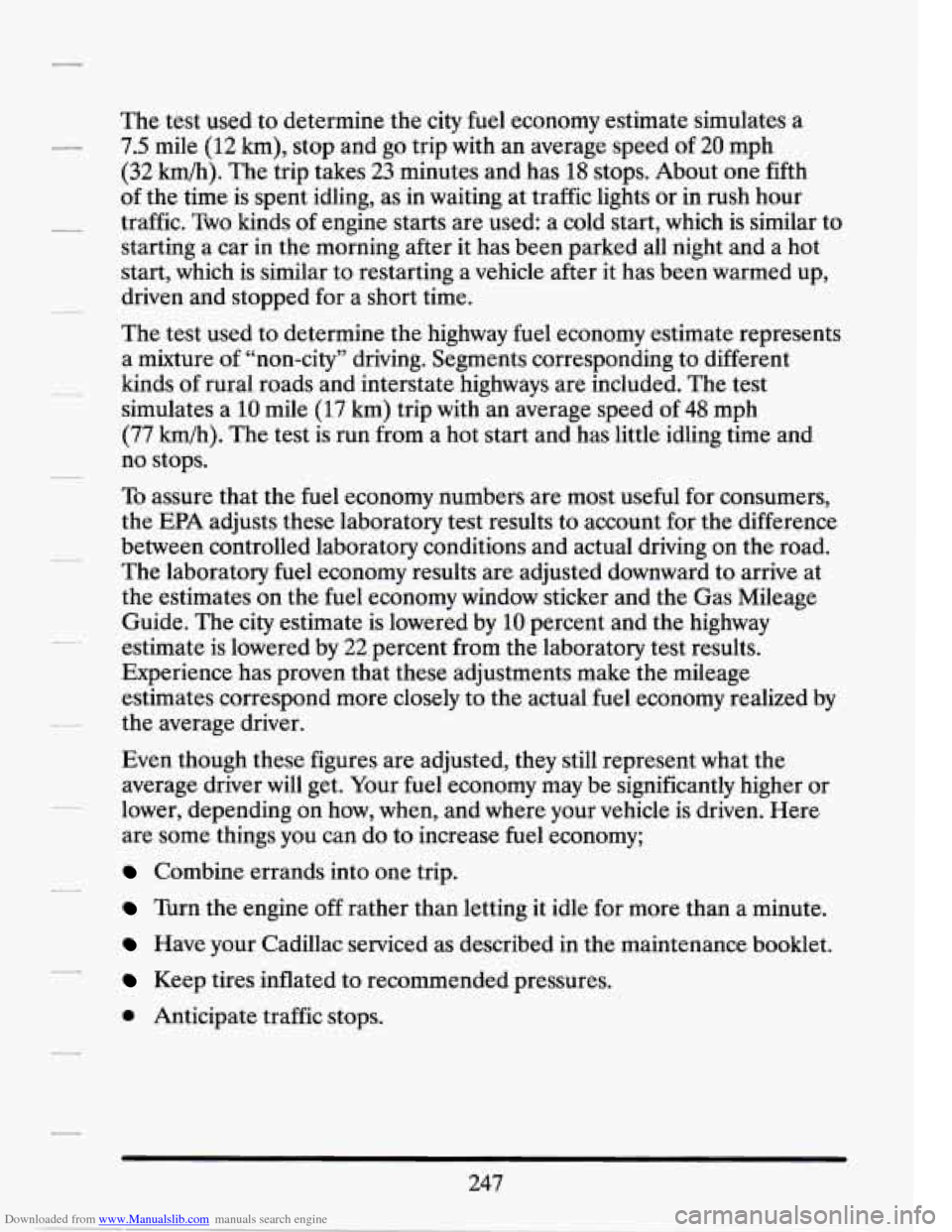
Downloaded from www.Manualslib.com manuals search engine -
The test used to determine me city fuel economy estimate simulates a
7.5 mile
(12 km), stop and go trip with an average speed of 20 mph
(32 km/h). The trip takes 23 minutes and has 18 stops. About one fifth
of the time is spent idling, as in waiting at traffic lights or in rush hour
traffic. Two kinds
of engine starts are used: a cold start, which is similar to
starting a car in the morning after it has been parked all night and a hot
start, which is similar to restarting
a vehicle after it has been warmed up,
driven and stopped for a short time.
The test used to determine the highway fuel economy estimate represents
a mixture
of “non-city” driving. Segments corresponding to different
kinds of rural roads and interstate highways are included. The test
simulates a
10 mile (17 km) trip with an average speed of 48 mph
(77
km/h). The test is run from a hot start and has little idling time and
no stops.
To assure that the fuel economy numbers are most useful for consumers,
the EPA adjusts these laboratory test results to account for the difference
between controlled laboratory conditions and actual driving on the road.
The laboratory fuel economy results are adjusted downward to arrive at
the estimates on the fuel economy window sticker and the Gas Mileage
Guide. The
city estimate is lowered by 10 percent and the highway
estimate is lowered by
22 percent from the laboratory test results.
Experience has proven that these adjustments make the mileage
estimates correspond more closely to the actual fuel economy realized by
the average driver.
Even though these figures are adjusted, they still represent what the
average driver will get. Your fuel economy may be significantly higher or
lower, depending on how, when, and where your vehicle is driven. Here
are some things you can do to increase fuel economy;
Combine errands into one trip.
Turn the engine off rather than letting it idle for more than a minute.
Have your Cadillac serviced as described in the maintenance booklet.
Keep tires inflated to recommended pressures.
0 Anticipate traffic stops.
247
Page 326 of 399
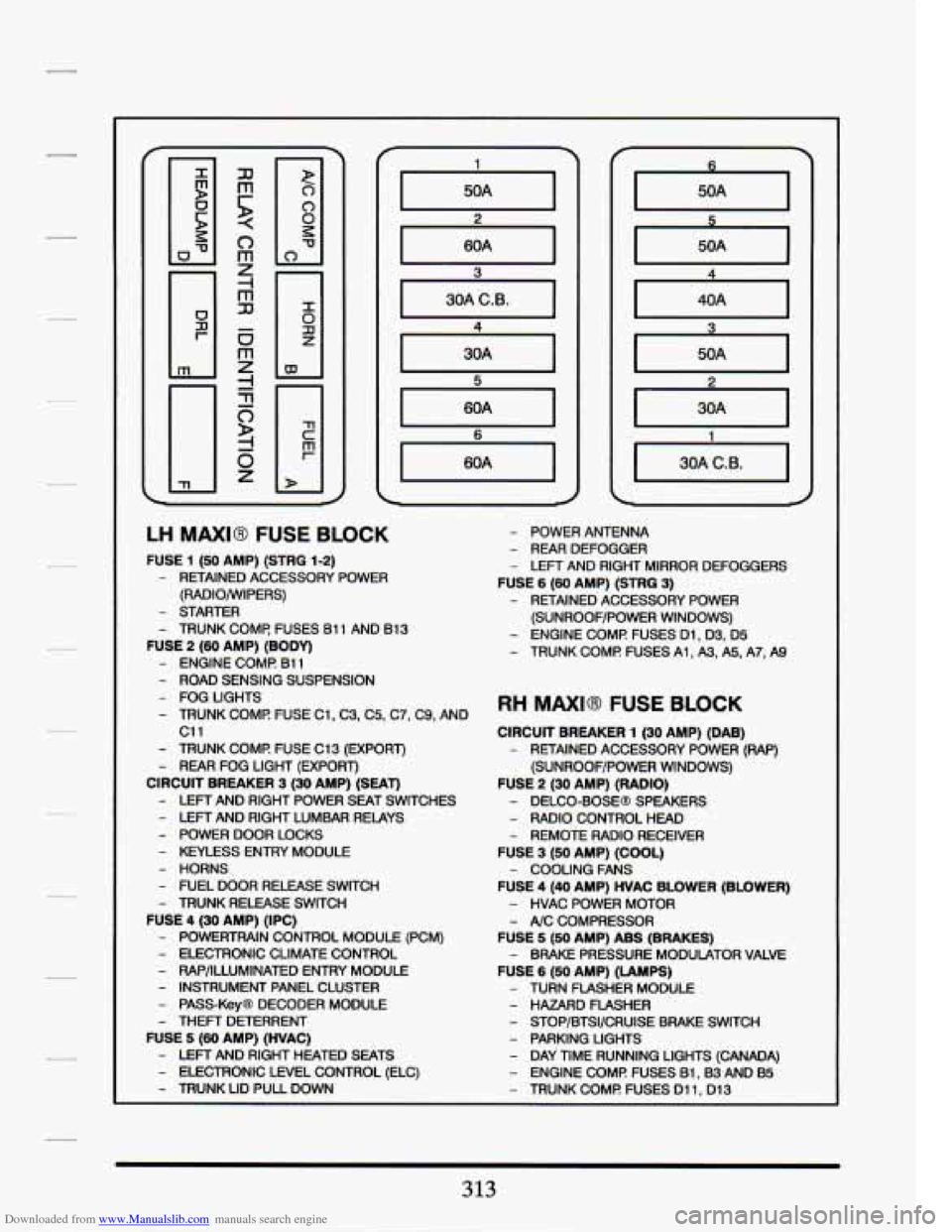
Downloaded from www.Manualslib.com manuals search engine 60A I
LH MAXI8 FUSE BLOCK
FUSE 1 (50 AMP) (STRG 1-2)
- RETAINED ACCESSORY POWER
(RADIO/WIPERS)
- STARTER
- TRUNK COMF! FUSES 61 1 AND 81 3
FUSE 2 (60 AMP) (BODY)
- ENGINE COMI? B11
- ROAD SENSING SUSPENSION
- FOG LIGHTS
- TRUNK COMI? FUSE C1, C3, C5, C7, C9, AND
c11
- TRUNK COME FUSE C13 (EXPORT)
- REAR FOG LIGHT (EXPORT)
CIRCUIT BREAKER 3 (30 AMP) (SEAT)
- LEFT AND RIGHT POWER SEAT SWITCHES
- LEFT AND RIGHT LUMBAR RELAYS
- POWER DOOR LOCKS
- KEYLESS ENTRY MODULE
- HORNS
- FUEL DOOR RELEASE SWITCH
- TRUNK RELEASE SWITCH
FUSE 4 (30 AMP) (IPC)
- POWERTRAIN CONTROL MODULE (PCM)
- ELECTRONIC CLIMATE CONTROL
- W/ILLUMINATED ENTRY MODULE
- INSTRUMENT PANEL CLUSTER
- PASS-Key@ DECODER MODULE
- THEFT DETERRENT
FUSE 5 (60 AMP) (HVAC)
- LEFT AND RIGHT HEATED SEATS
- ELECTRONIC LEVEL CONTROL (ELC)
- TRUNK LID PULL DOWN
- POWER ANTENNA
- REAR DEFOGGER
- LEFT AND RIGHT MIRROR DEFOGGERS
FUSE 6 (60 AMP) (STRQ 3)
- RETAINED ACCESSORY POWER
(SUNROOF/POWER WINDOWS)
- ENGINE COMI? FUSES Dl, 03, D5
- TRUNK COMI? FUSES A1 , A3, A5, A7, A9
RH MAXI@ FUSE BLOCK
CIRCUIT BREAKER 1 (30 AMP) (DAB)
- RETAINED ACCESSORY POWER (RAP)
(SUNROOF/POWER WINDOWS)
FUSE 2 (30 AMP) (RADIO)
- DELCO-BOSEB SPEAKERS
- RADIO CONTROL HEAD
- REMOTE RADIO RECEIVER
FUSE 3 (50 AMP) (COOL)
FUSE
4 (40 AMP) HVAC BLOWER (BLOWER)
- COOLING FANS
- HVAC POWER MOTOR
- A/C COMPRESSOR
FUSE 5 (So AMP) ABS (BRAKES)
FUSE
6 (So AMP) (LAMPS)
- BRAKE PRESSURE MODULATOR VALVE
- TURN FLASHER MODULE
- HAZARD FLASHER
- STOP/BTSI/CRUISE BRAKE SWITCH
- PARKING LIGHTS
- DAY TIME RUNNING LIGHTS (CANADA)
- ENGINE COMI? FUSES Bl,B3 AND B5
- TRUNK COMI? FUSES Dl 1, Dl3
313
Page 383 of 399
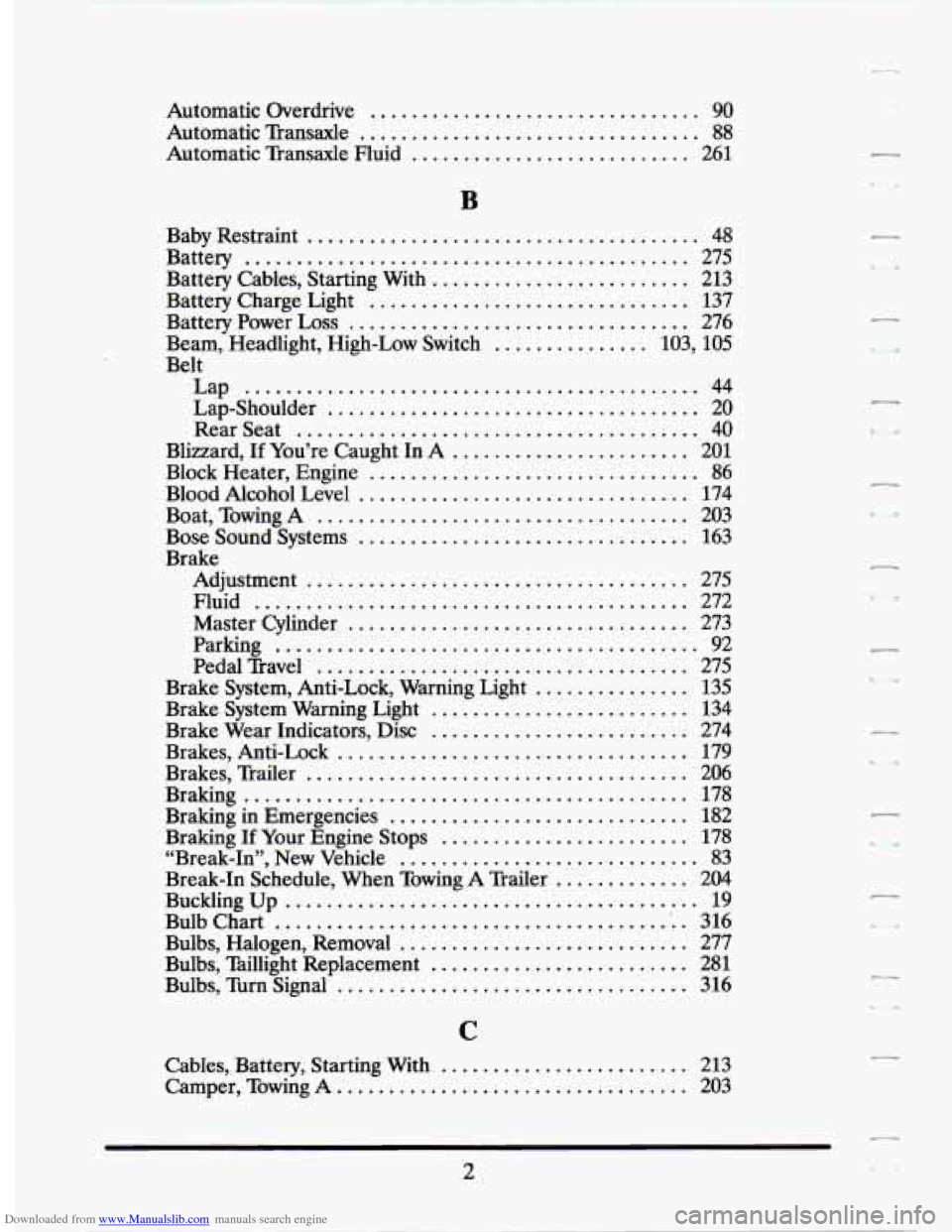
Downloaded from www.Manualslib.com manuals search engine Automatic Overdrive ................................ 90
Automatic Transaxle ................................. 88
Automatic Transaxle Fluid ........................... 261 r
B
Baby Restraint ...................................... 48
Battery ........................................... 275
Battery Cables. Starting With ......................... 213
Battery Charge Light ............................... 137
Battery Power Loss ................................. 276
Beam. Headlight. High-Low Switch ............... 103. 105
Belt
Lap
............................................ 44
Lap-Shoulder .................................... 20
Rear Seat ....................................... 40
Blizzard. If You’re Caught In A ....................... 201
Block Heater. Engine ................................ 86
BloodAlcoholLevel ................................ 174
Boat. Towing A .................................... 203
Bose Sound Systems ................................ 163
Brake
Adjustment
..................................... 275
Fluid .......................................... 272
Master Cylinder ................................. 273
Parking ......................................... 92
Pedal Travel .................................... 275
Brake System Warning Light ......................... 134
Brake Wear Indicators. Disc ......................... 274
Brakes. Anti-Lock .................................. 179
Brakes. Trailer ..................................... 206
Braking ........................................... 178
Braking in Emergencies ............................. 182
“Break.1n.’. New Vehicle ............................. 83
Buckling Up ......................................... 19
Bulb Chart .........................................
Brake System. Anti.Lock. Warning Light ............... 135
Braking If Your Engine Stops ........................ 178
Break-In Schedule. When Towing A Trailer ............. 204
Bulbs. Halogen. Removal ............................
Bulbs. Taillight Replacement .........................
Bulbs. Turn Signal ..................................
C
Cables. Battery. Starting With ........................
Camper. Towing A ..................................
316
277
281
316
213
203
.
.
.
r
.
.
.
r
1
.
2